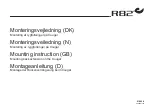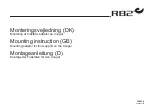
930494 Rev. A
6
E N G L I S H
J. MOTOR VEHICLE SAFETY
WARNING
Quickie wheelchairs do not meet federal standards for motor vehicle seating.
1.
NEVER let anyone sit in this chair while in a moving vehicle.
a.
ALWAYS move the rider to an approved vehicle seat.
b.
ALWAYS secure the rider with proper motor vehicle restraints.
2.
In an accident or sudden stop the rider may be thrown from the
chair. Wheelchair seat belts will not prevent this, and further injury
may result from the belts or straps.
3.
NEVER transport this chair in the front seat of a vehicle. It may shift
and interfere with the driver.
4.
ALWAYS secure this chair so that it cannot roll or shift.
5.
Do not use any chair that has been involved in a motor vehicle accident.
If you fail to heed these warnings damage to your chair, a fall, tip-over or loss of control
may occur and cause severe injury to the rider or others.
K. WHEN YOU NEED HELP
WARNING
For The Rider:
Make sure that each person who helps you reads and follows all warnings
and instructions that apply.
For Attendants:
1.
Work with the rider’s doctor, nurse or therapist to learn safe meth-
ods best suited to your abilities and those of the rider.
2.
Tell the rider what you plan to do, and explain what you expect the
rider to do. This will put the rider at ease and reduce the risk of an
accident.
3.
Make sure the chair has push handles. They provide secure points
for you to hold the rear of the chair to prevent a fall or tip-over.
Check to make sure push handle grips will not rotate or slip off.
4.
To prevent injury to your back, use good posture and proper body
mechanics. When you lift or support the rider or tilt the chair, bend your
knees slightly and keep your back as upright and straight as you can.
5.
Remind the rider to lean back when you tilt the chair backward.
6.
When you descend a curb or single step, slowly lower the chair in
one easy movement. Do not let the chair drop the last few inches to
the ground. This may damage the chair or injure the rider.
7.
To avoid tripping, unlock and rotate anti-tip tubes up, out of the way.
ALWAYS lock the rear wheels, and lock anti-tip tubes in place if you
must leave the rider alone, even for a moment. This will reduce the
risk of a tip-over or loss of control of the chair.
If you fail to heed these warnings damage to your chair, a fall, tip-over or loss of control
may occur and cause severe injury to the rider or others.
G. ENVIRONMENTAL CONDITIONS
WARNING
1.
Use extra care if you must ride your chair on a wet or slick surface.
If you are in doubt, ask for help.
2.
Contact with water or excess moisture may cause your chair to rust
or corrode. This could cause your chair to fail.
a.
Do not use your chair in a shower, pool or other body of water.
The chair tubing and parts are not water-tight and may rust or
corrode from the inside.
b.
Avoid excess moisture (for example, do not leave your chair in a
damp bathroom while taking a shower).
c.
Dry your chair as soon as you can if it gets wet, or if you use
water to clean it.
If you fail to heed these warnings damage to your chair, a fall, tip-over or loss of control
may occur and cause severe injury to the rider or others.
H. TERRAIN
WARNING
1.
Your chair is designed for use on firm, even surfaces such as con-
crete, asphalt and indoor floors and carpeting.
2.
Do not operate your chair in sand, loose soil or over rough terrain.
This may damage wheels or axles, or loosen fasteners of your chair.
If you fail to heed these warnings damage to your chair, a fall, tip-over or loss of control
may occur and cause severe injury to the rider or others.
I. STREET USE
WARNING
In most states, wheelchairs are not legal for use on public roads.
Be alert to the danger of motor vehicles on roads or in parking lots.
1.
At night, or when lighting is poor, use reflective tape on your chair
and clothing.
2.
Due to your low position, it may be hard for drivers to see you.
Make eye contact with drivers before you go forward. When in
doubt, yield until you are sure it is safe.
If you fail to heed these warnings damage to your chair, a fall, tip-over or loss of control
may occur and cause severe injury to the rider or others.







































